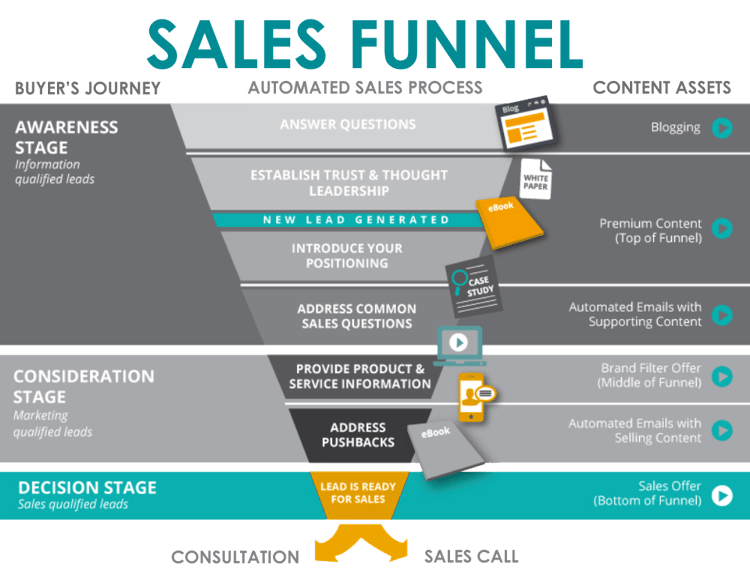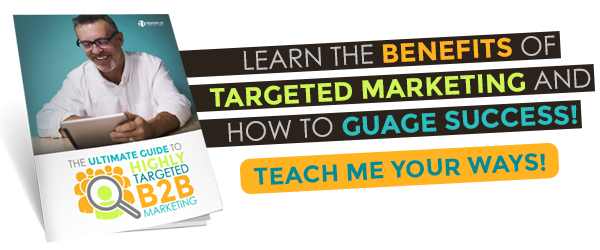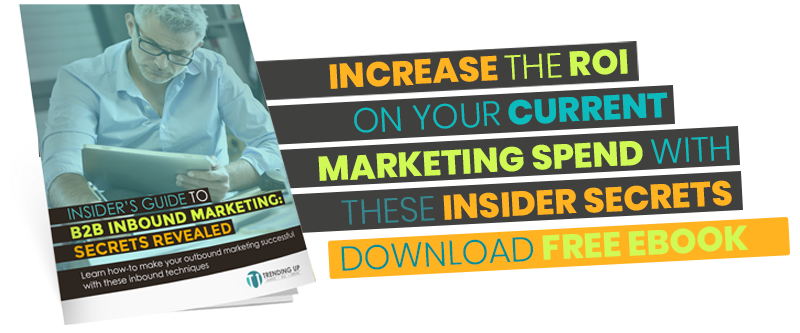By developing content aligned to users’ needs at every step of your sales funnel, you can motivate prospects to self-qualify. This can save your sales team hundreds of hours annually, focusing your sales resources on clients who suit you best who are also ready to buy.
An effective inbound marketing strategy team will sit down with your sales and marketing teams to discover and create clear definitions for leads, marketing qualified leads, and sales qualified leads, along with defining simple ways to move buyers through the funnel from one stage to another using content on your site and a clear sales and marketing alignment.
No matter what your sales funnel looks like, two of the most important and typically the hardest stages to decipher are marketing qualified leads (MQL's) and sales qualified leads (SQL's). If your marketing and sales teams aren't clear on the definitions for these lead types and the process for handing them off, you could slow your sales cycle and miss out on closed sales.
Defining MQL and SQL for Your Enterprise
There is no one definition for MQL and SQL: It changes based on your industry, sales process and customer profile. Sales and marketing needs to come together in a collaborative effort to define the terms as they apply to your business.
To help you define MQL and SQL you need to consider:
- Buyer Personas: Who are you targeting and why? A buyer persona serves as a capsule definition of someone best positioned to convert. It’s crucial to discover which prospects fit into your personas – and to refine them over time.
- Data Provided by Leads: What information are you capturing from leads? Is the data sufficient to qualify the lead? Is it appropriate for the lead’s engagement level at the time?
- Website Behaviors: How many times has a prospect been to your site? What content did they view? Which platform led them to your site? Have they downloaded content or subscribed to offers? Both this and the data above can provide data for lead scoring, enabling automation and better qualification.
- Demography: If the prospect volunteered an email address, is it business or personal? What industry is the prospect in? What role does the prospect play in the company's buying decisions?
You can think of a marketing-qualified lead (MQL) as someone who engages with your brand, going “on your radar” by showing interest in your offerings and visiting your website. A sales-qualified lead (SQL) is an MQL who has demonstrated clear purchase intent that is verified by a salesperson.
Not all MQLs become SQLs. Making efficient use of your resources means automating your marketing so all leads are pre-qualified before your staff invests time in them. Once prospects move into your sales funnel, you can “score” their position on the MQL-SQL continuum based on their behavior.
Aligning Offers With the Buyer’s Journey
To introduce the best leads into your pipeline, you need to know which prospects you plan to target. That starts with clarity about what makes someone an MQL. Only then can sales and marketing collaborate to ensure offers are effective and align with the top questions prospects ask. A clear marketing and sales strategy will define specific content titles for each of these stages, making the qualification process easier for your teams.

There should be several premium educational offers for prospects to engage with no matter where they stand in their buying journey. Depending on which offer they choose and what pages they view, you will gain a better understanding of how to qualify them. It will also ensures you are providing actionable insights on which offers are most effective for each market segment.
Let’s consider a buyer’s journey related to the manufacturing industry and potential content offers that are relevant to each stage:
Discovery/Awareness
Using informative, benefits-focused giveaway, such as an ebook, the prospect learns more about the impact of your service without being compelled to make decisions. By downloading this ebook, the prospect becomes a lead that is "information-qualified." If the lead has given information that makes them qualified - matching interest levels, budget, location, and other demographics needed - they may move on to the marketing qualified lead status next.
Consideration
A differentiation-focused offer should be given at the consideration stage. For example, “A 7-Step Checklist for Choosing a Six Sigma Vendor.” This aids the selection process and allows you to position your expertise, but should be truthful and still purely informative; no selling!
Decision
At this stage, content should require the prospect to take action like, a call-to-action: “Request a Quote” or “Free Consultation”. A decision-stage offer should have very specific content geared toward selecting a vendor that looks like you - and differentiate you even more from competitors.
If a prospect sees your site for the first time, reads six pages, and subscribes to your discovery-stage offer, plus meets many of your qualifying identifiers, you most likely have an MQL. It’s important to focus on how behavior changes in subsequent visits. If, a week later, the user is taking actions with many consideration stage offers, it's time for a salesperson to contact them as they're clearly an engaged prospect looking for answers.
Once you define an MQL, it is easier to design a process that draws the right people into the sales funnel. From there, sales teams should have separate criteria letting them score leads further and make the transition from MQL to SQL.
What Does a Lead Look Like for Your Business?
Not all leads are classified neatly as an SQL or MQL.
Your lead pool might have subscribers, opportunities, or even evangelists. The key to success is simple: Having a strategy built on agreement between sales and marketing about who’s an MQL, who’s an SQL, and who is neither. For each lead type, there should be specific processes in place so you can maximize sales and revenue. Ideally, part of the scoring and assigning process would also be automated to increase efficiency, as well.
Some prospects don’t need a sales pitch. For them, your offer speaks for itself. By searching for MQLs, you widen your funnel and raise the odds of reaching those motivated outliers. True, a conversion is a conversion – but having definitions of MQL and SQL will focus your lead generation efforts where they can have the most impact.






